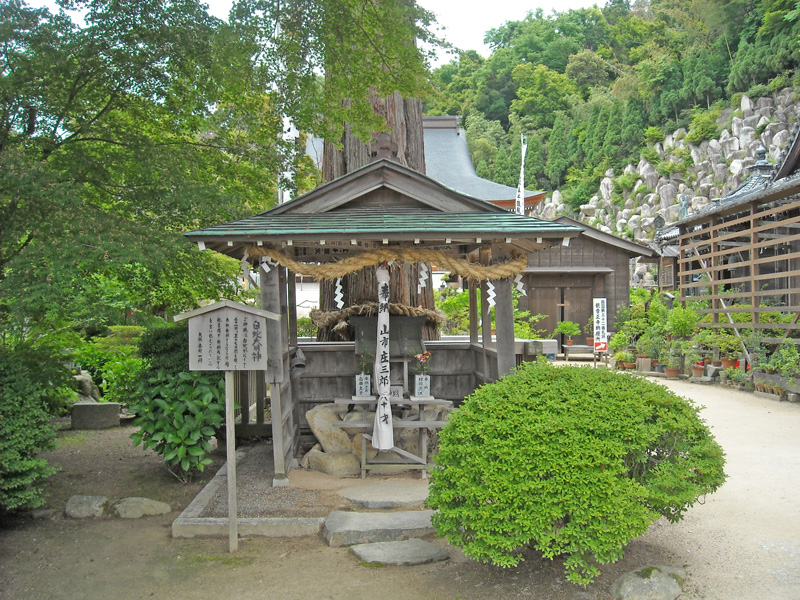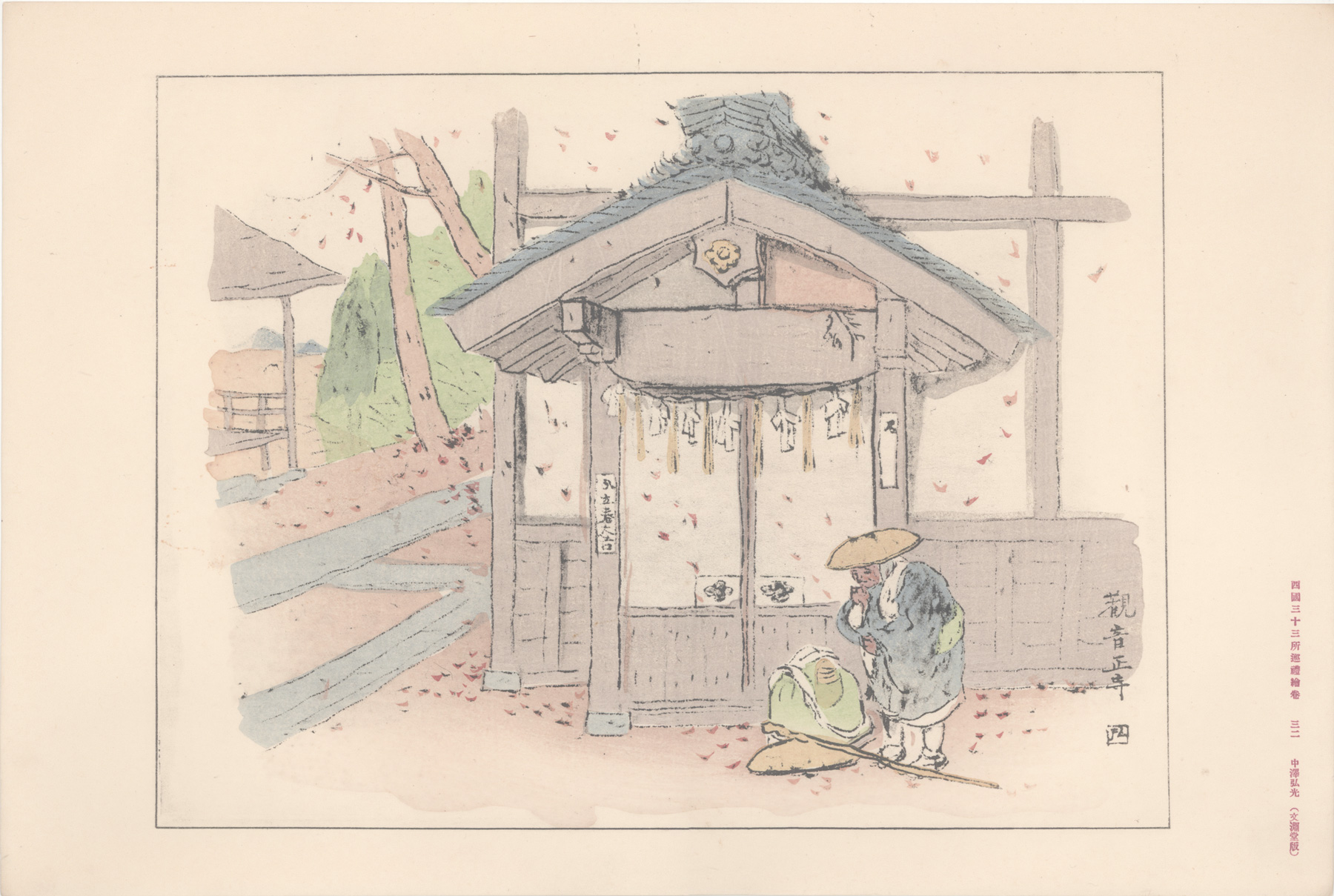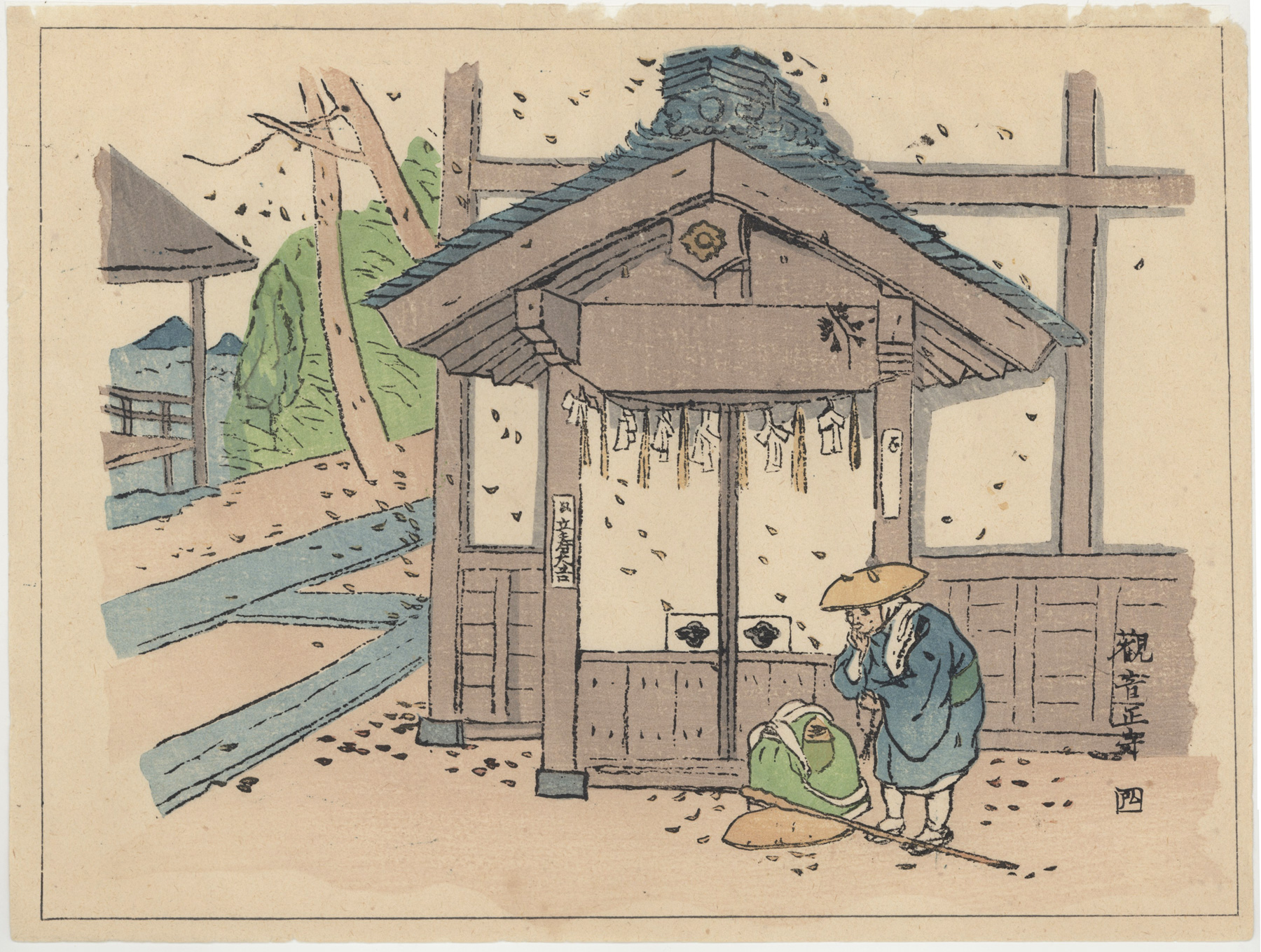About This Print
Kannonshō-ji sits near the top of Mt. Kinugasa overlooking Lake Biwa in Shiga prefecture and is the 32nd temple on the Saigoku Kannon pilgrimage. Nakazawa chooses to show us a single pilgrim holding prayer beads with his traveling pack and staff lying next to him.
In 1993 much of the temple burned down, but today the reconstruction is complete.
On December 1923, only a few months after the Great Kantō Earthquake devastated the Tokyo area, Nakazawa along with his two friends, the poet Ishikura Suiyō and the artist Akatsuka Chūichi, began their pilgrimage to the thirty-three temples comprising the Saigoku Kannon Pilgrimage, taking seventy-eight days to complete the route.
For more information on their pilgrimage see the article Nakazawa Hiromitsu - Picture Album of the Thirty-Three Pilgrimage Places of the Western Provinces.
The main enshrined image (honzon) of the temple is the bodhisattva Kannon, Senjūsengen Jūichimen which is shown to the public every thirty-three years and been designated an Important Cultural Property.
"The mountain on which Kannonshōji is located abounds with boulders and caves. The boulders are enormous, up to seven meters across, and their looming presence casts an uncanny spell over the mountain. The site has been an important center of Shugendō [an amalgamation of Shinto and Buddhism] activity since the Muromachi period [1333-1573]... Early Shugenja left records of their presence in the form of Buddhist images which they carved in relief in the faces of several of the boulders; some of these date back to the Heian period [794-1185]."1
The goeika, or temple song/prayer, of Kannonshō-ji goes:
Spring flowers, Autumn leaves, change thecolors, I want to learn the Land of Buddha.

Kannonshō-ji Principal Enshrined Deity
Senjūsengen Jūichimen
image source: https://f.hatena.ne.jp/funaman/20130601130830
1 Japanese Buddhist Art in Context: The Saikoku Kannon Pilgrimage Route, Volume 1, a dissertation by Patricia Frame Rugola, The Ohio State University, 1986, p. 104. The Saigoku Kannon Pilgrimage (Saigoku sanjūsansho junrei)
Japan's most famous pilgrimage, originating in the 11th century, encompasses 33 Buddhist temples in Western Japan (Kansai region) dedicated to Kannon (bodhisattva Avalokitasvara), the Bodhisattva of Compassion, who hears the cries of the world and assists anyone in distress.
The 33 temples on the approximately 1,000 kilometer pilgrimage route correspond to Kannon's ability to take on 33 different forms. One hundred thousand pilgrims navigate the route in its entirety or part each year.
Note: For a listing of all 33 temples go to https://en.wikipedia.org/wiki/Saigoku_Kannon_Pilgrimage. To access an interactive map of the route and its temples go to https://www.thetempleguy.org/p/saigoku-33-kannon-route.html and scroll down towards the bottom of the page.
About the "Picture Album of the Thirty-Three Pilgrimage Places of the Western Provinces"
First issued in 1925 and reprinted in 1946, the 1925 album contains 58 prints and the 1946 album 59 prints. For detailed discussion of the two editions and additional information on the Saigoku Kannon Pilgrimage see this site's article Nakazawa Hiromitsu - Picture Album of the Thirty-Three Pilgrimage Places of the Western Provinces.
Print Details
IHL Catalog
#1856 (1946 second edition) and #2413.40 (1925 first edition) Title or Description Kannonshō-ji (temple 32)
観音正寺 (三十二) Series Picture Album of the Thirty-Three Pilgrimage Places of the Western Provinces
西国三十三所巡礼画巻 Saigoku sanjūsansho junrei gakan Artist Nakazawa Hiromitsu (1874-1964)
Signature  IHL Cat. #2413.40 (1925 release): 中澤弘光 [Nakazawa Hiromitsu] printed in lower right margin as shown left
IHL Cat. #2413.40 (1925 release): 中澤弘光 [Nakazawa Hiromitsu] printed in lower right margin as shown left
IHL Cat. #1856 (1946 release): not signed Seal of the artist 
 弘 Hiro
弘 Hiro
left seal: IHL Cat. #2413.40 (1925 release)
right seal: IHL Cat. 1856 (1946 release) Publication Date IHL Cat. #2413.40: Published September 28, 1925 大正十四年九月十八日発行 as printed in the 1925 album's colophon (see Album Box with Print of Kannon IHL Cat. 2413).
Note: an earlier date of June 15, 1925 大正十四年六月十五日 appears in the right margin of the print titled Matsunoo-dera [IHL Cat. #2245], the only print in the 1925 album which carries a date. This earlier date, however, is the date that the censor's approval was obtained, as further explained on this site's web page for Matsunoo-dera, rather than the publishing date.
IHL Cat. #1856: January 18, 1946 昭和二十一年一月十八日発行 [Individual prints in the 1946 release are not dated. This date taken from a 1946 album colophon.] Publisher 發行者 金尾種次郎 publisher Kanao Tanejirō
發兌元 金尾文淵堂 publishing house Kanao Bun'endō
IHL Cat. #2413.40 (1925 release): 文淵堂版 [Bun'endō han] printed in lower right margin as shown left
IHL Cat. #1856 (1946 release): no publisher seal Carver Okada Seijirō 岡田清次郎
Note: the album's colophon (see Album Box with Print of Kannon IHL Cat. 2413) lists two carvers, the above well-known Okada Seijirō and 大倉藤太郎, possibly read Okura Tōtarō, who I can find no information on. . Printer IHL Cat. #2413.40 (1925 release): Nishimura Kumakichi 西村熊吉
Note: the colophon for the 1925 album (see Album Box with Print of Kannon IHL Cat. 2413) lists three printers, the above well-known Nishmura Kumakichi; 山県秀助, possibly read Yamagata Hidesuki, who I can find no information on, and 松本兄弟堂, a company founded in Osaka by Matsumoto Kisaburō 松本喜三郎 in 1923, which I believe did the letterpress printing.
IHL Cat. #1856 (1946 release): Nishimura Kumakichi 西村熊吉 and
Takagi Seikō (Takagi Kiyomitsu?) 高木淸光
Note: the above information is taken from the colophon included in the 1946 release. I could find no information on the second printer listed for the 1946 release 高木淸光.
Note on Nishimura Kumakichi: listed as one of the printers for both the 1925 and 1946 release, there is some uncertainty about the date of his death, although a birth date, either 1861 or 1862 [Guide to Modern Japanese Woodblock Prints, Merritt, p. 223], is generally accepted. A death date of 1941 is sometimes given and 1955 has been suggested, but Merritt provides no date of death. If he truly did the printing for the 1946 release he would have been around 85 at that time. Impression IHL Cat. #2413.40 (1925 release): excellent
IHL Cat. #1856 (1946 release): excellent Colors IHL Cat. #2413.40 (1925 release): excellent
IHL Cat. #1856 (1946 release): excellent Condition IHL Cat. #2413.40 (1925 release): excellent - minor printer marks and handling creases
IHL Cat. #1856: fair - paper wrinkling along top 2 inches of print; paper fraying long top margin and tear along top of left margin, repaired with paper tape from verso; paper loss top right corner.
Genre shin hanga; shasei kikō (sketch-tour) Miscellaneous Nakazawa Hiromitsu kenkyū: Hon karano kenshō, Hiromitsu Nakazawa, Mitsunobu Satō, et. al., Mitsui Kōkei, Tokyo, 2006, p. 46-48. Format horizontal oban
H x W Paper
IHL Cat. #2413.40 (1925 release): 10 1/8 x 15 3/16 in. (25.7 x 38.6 cm)
IHL Cat. #1856 (1946 release): 9 x 12 in. (22.9 x 30.5 cm)
H x W Image
IHL Cat. #2413.40 (1925 release): 8 1/2 x 11 9/16 in. (21.6 x 29.4 cm)
IHL Cat. #1856 (1946 release): 8 1/2 x 11 9/16 in. (21.6 x 29.4 cm)
Literature Collections This Print
National Diet Library Call Number 寄別7-8-2-5 (1925 album, no images displayed); National Library Board, Singapore BRN:9854371 (entire 1946 album, no images shown); British Library System number: 017018582 (entire 1946 album, no images shown); Harvard Yenching Library HOLLIS number 990082993710203941 (1925 album, no images displayed)
| IHL Catalog | #1856 (1946 second edition) and #2413.40 (1925 first edition) |
| Title or Description | Kannonshō-ji (temple 32) 観音正寺 (三十二) |
| Series | Picture Album of the Thirty-Three Pilgrimage Places of the Western Provinces 西国三十三所巡礼画巻 Saigoku sanjūsansho junrei gakan |
| Artist | Nakazawa Hiromitsu (1874-1964) |
| Signature |  IHL Cat. #1856 (1946 release): not signed |
| Seal of the artist |   left seal: IHL Cat. #2413.40 (1925 release) right seal: IHL Cat. 1856 (1946 release) |
| Publication Date | IHL Cat. #2413.40: Published September 28, 1925 大正十四年九月十八日発行 as printed in the 1925 album's colophon (see Album Box with Print of Kannon IHL Cat. 2413). Note: an earlier date of June 15, 1925 大正十四年六月十五日 appears in the right margin of the print titled Matsunoo-dera [IHL Cat. #2245], the only print in the 1925 album which carries a date. This earlier date, however, is the date that the censor's approval was obtained, as further explained on this site's web page for Matsunoo-dera, rather than the publishing date. IHL Cat. #1856: January 18, 1946 昭和二十一年一月十八日発行 [Individual prints in the 1946 release are not dated. This date taken from a 1946 album colophon.] |
| Publisher | 發行者 金尾種次郎 publisher Kanao Tanejirō 發兌元 金尾文淵堂 publishing house Kanao Bun'endō  IHL Cat. #2413.40 (1925 release): 文淵堂版 [Bun'endō han] printed in lower right margin as shown left IHL Cat. #1856 (1946 release): no publisher seal |
| Carver | Okada Seijirō 岡田清次郎 Note: the album's colophon (see Album Box with Print of Kannon IHL Cat. 2413) lists two carvers, the above well-known Okada Seijirō and 大倉藤太郎, possibly read Okura Tōtarō, who I can find no information on. . |
| Printer | IHL Cat. #2413.40 (1925 release): Nishimura Kumakichi 西村熊吉 Note: the colophon for the 1925 album (see Album Box with Print of Kannon IHL Cat. 2413) lists three printers, the above well-known Nishmura Kumakichi; 山県秀助, possibly read Yamagata Hidesuki, who I can find no information on, and 松本兄弟堂, a company founded in Osaka by Matsumoto Kisaburō 松本喜三郎 in 1923, which I believe did the letterpress printing. IHL Cat. #1856 (1946 release): Nishimura Kumakichi 西村熊吉 and Takagi Seikō (Takagi Kiyomitsu?) 高木淸光 Note: the above information is taken from the colophon included in the 1946 release. I could find no information on the second printer listed for the 1946 release 高木淸光. Note on Nishimura Kumakichi: listed as one of the printers for both the 1925 and 1946 release, there is some uncertainty about the date of his death, although a birth date, either 1861 or 1862 [Guide to Modern Japanese Woodblock Prints, Merritt, p. 223], is generally accepted. A death date of 1941 is sometimes given and 1955 has been suggested, but Merritt provides no date of death. If he truly did the printing for the 1946 release he would have been around 85 at that time. |
| Impression | IHL Cat. #2413.40 (1925 release): excellent IHL Cat. #1856 (1946 release): excellent |
| Colors | IHL Cat. #2413.40 (1925 release): excellent IHL Cat. #1856 (1946 release): excellent |
| Condition | IHL Cat. #2413.40 (1925 release): excellent - minor printer marks and handling creases IHL Cat. #1856: fair - paper wrinkling along top 2 inches of print; paper fraying long top margin and tear along top of left margin, repaired with paper tape from verso; paper loss top right corner. |
| Genre | shin hanga; shasei kikō (sketch-tour) |
| Miscellaneous | Nakazawa Hiromitsu kenkyū: Hon karano kenshō, Hiromitsu Nakazawa, Mitsunobu Satō, et. al., Mitsui Kōkei, Tokyo, 2006, p. 46-48. |
| Format | horizontal oban |
| H x W Paper | IHL Cat. #2413.40 (1925 release): 10 1/8 x 15 3/16 in. (25.7 x 38.6 cm) IHL Cat. #1856 (1946 release): 9 x 12 in. (22.9 x 30.5 cm) |
| H x W Image | IHL Cat. #2413.40 (1925 release): 8 1/2 x 11 9/16 in. (21.6 x 29.4 cm) IHL Cat. #1856 (1946 release): 8 1/2 x 11 9/16 in. (21.6 x 29.4 cm) |
| Literature | |
| Collections This Print | National Diet Library Call Number 寄別7-8-2-5 (1925 album, no images displayed); National Library Board, Singapore BRN:9854371 (entire 1946 album, no images shown); British Library System number: 017018582 (entire 1946 album, no images shown); Harvard Yenching Library HOLLIS number 990082993710203941 (1925 album, no images displayed) |
last revision:
1/23/2021
12/20/2020
7/4/2020
2/22/2020
1/5/2020 created



